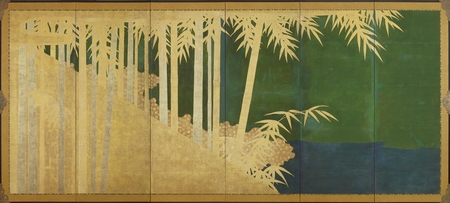Product Description
6713 A six-fold paper screen painted in ink and colour on a gold ground with a take (bamboo) grove on a knoll beside a river amongst clouds. Some of the clouds and the bamboo are rendered in moriage (raised design) and varying shades of gold have been used to achieve a sense of depth.
Hasegawa School
Japan 17th century Edo period
Dimensions: H. 67″ x W.147¼” (170cm x 373.5cm)
Take (bamboo) in Taoism and to a lesser extent in Buddhism symbolises the notion of emptiness, due to its tube-like structure. Just as the tao (the ineffable ‘way’ of Taoism) arises from nothing and returns to emptiness, the bamboo is empty at its core. In East Asian philosophy such emptiness is perceived in a positive rather than a negative light. It is also a symbol of purification.
Bamboo also represents strength, vitality and survival through adversity due to its evergreen nature and delicate structure which bends in the wind, but never breaks. It is also one of the Three Friends of Winter along with the plum and the pine, each symbolizing perseverance and integrity as they survive the winter without withering. Ancient Chinese scholars admired the strength, dependability and flexibility of bamboo and aspired to these characteristics. The practice of painting bamboo also employs the full range of calligraphic brushstrokes and is therefore considered to symbolise the gentleman scholar.
Haiku by Otagaki Rengetsu (1791-1875) on bamboo:
Kono kimi wa
medetakifushiwo kasanetsutsu
sue nodainagaki
tameshinarikeri
This gentleman
Grows and grows
Most auspiciously
Learn from him and
You, too, will flourish forever.
The Hasegawa School was founded by Hasegawa Tōhaku (1539-1610) in the late 16th century. Despite being small, consisting mostly of Tōhaku, his sons and sons-in-law it is known today as one of the most influential artistic groups of the period. Its members conserved Tōhaku’s quiet and reserved aesthetic, which many attribute to the influence of Sesshū Tōyō (1420-1506) as well as his contemporary and friend, Sen no Rikyū (1522-1591).
For a set of four fusuma from the 17th century depicting bamboo in a similar manner from the Hasegawa School in the collection of Hojo, Zenrin-ji, Kyoto see: The Heibonsha Survey of Japanese Art, Volume 14 Momoyama Decorative Painting, 1977, p.107, pl. 92.
Provenance: previously in the collection of Hubert de Givenchy






